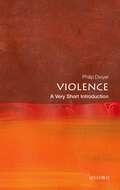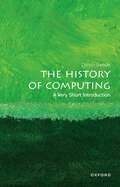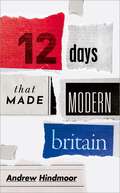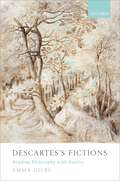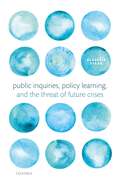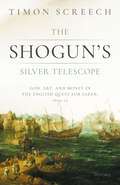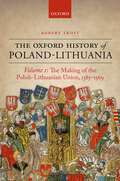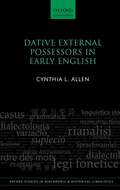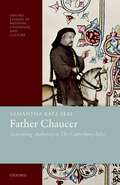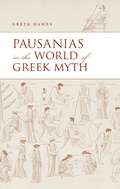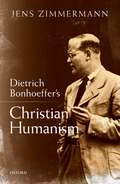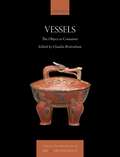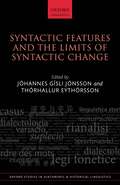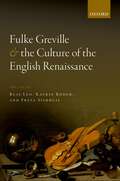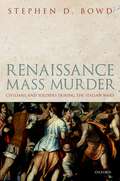- Table View
- List View
Violence: A Very Short Introduction (Very Short Introductions)
by Philip DwyerVery Short Introductions: Brilliant, Sharp, Inspiring Violence is part and parcel of human history and of human nature. It is one of our most distinctive traits, the one thing that all cultures and societies, across time, share in common. It has defined not only the ways in which individuals relate to each other, but also how collective entities and states have interacted with each other over the millennia. All societies are violent and all individuals have the capacity for violence. However, not all societies and not all individuals are equally violent, and nor does violence exist with the same intensity across cultures. This Very Short Introduction examines the more visible, physical acts of violence - interpersonal, gendered, collective, religious, sexual, criminal, and political - in the modern world. It explores how violence in the pre-modern world was different from the modern world, and what is significant about those differences. It also discusses what violence is by examining understandings of the ideas, values, and cultural practices embedded in an act of violence, and considering acts of violence as the outcome of a process dependent on the cultural context in which they take place. Along the way Dwyer considers some core questions, asking whether violence is always 'bad', and if there are any limits to human violence? Why is it that what was once considered acceptable - wife beating, duelling, slavery - at some point becomes unacceptable in some societies and cultures, and yet continues in others? And finally, are we becoming more or less violent? ABOUT THE SERIES: The Very Short Introductions series from Oxford University Press contains hundreds of titles in almost every subject area. These pocket-sized books are the perfect way to get ahead in a new subject quickly. Our expert authors combine facts, analysis, perspective, new ideas, and enthusiasm to make interesting and challenging topics highly readable.
Violence: A Very Short Introduction (Very Short Introductions)
by Philip DwyerVery Short Introductions: Brilliant, Sharp, Inspiring Violence is part and parcel of human history and of human nature. It is one of our most distinctive traits, the one thing that all cultures and societies, across time, share in common. It has defined not only the ways in which individuals relate to each other, but also how collective entities and states have interacted with each other over the millennia. All societies are violent and all individuals have the capacity for violence. However, not all societies and not all individuals are equally violent, and nor does violence exist with the same intensity across cultures. This Very Short Introduction examines the more visible, physical acts of violence - interpersonal, gendered, collective, religious, sexual, criminal, and political - in the modern world. It explores how violence in the pre-modern world was different from the modern world, and what is significant about those differences. It also discusses what violence is by examining understandings of the ideas, values, and cultural practices embedded in an act of violence, and considering acts of violence as the outcome of a process dependent on the cultural context in which they take place. Along the way Dwyer considers some core questions, asking whether violence is always 'bad', and if there are any limits to human violence? Why is it that what was once considered acceptable - wife beating, duelling, slavery - at some point becomes unacceptable in some societies and cultures, and yet continues in others? And finally, are we becoming more or less violent? ABOUT THE SERIES: The Very Short Introductions series from Oxford University Press contains hundreds of titles in almost every subject area. These pocket-sized books are the perfect way to get ahead in a new subject quickly. Our expert authors combine facts, analysis, perspective, new ideas, and enthusiasm to make interesting and challenging topics highly readable.
The History of Computing: A Very Short Introduction (Very Short Introductions)
by Doron SwadeVery Short Introductions: Brilliant, Sharp, Inspiring This lively Very Short Introduction reviews the central events, machines, and people that feature in established accounts of the history of computing, critically examining received perceptions and providing a fresh look at the nature and development of the modern electronic computer. The book begins by discussing a widely accepted linear narrative of the history of computing, centred around innovatory highlights that start with the use of knotted cords to aid calculation, all the way to the smartphones of the present day. It discusses the problems and simplifications present in such a narrative, and offers instead an account, centred on users, that identifies four distinct historical threads: calculation, automatic computing, information management, and communication. These threads are examined individually, tracing their paths and the convergences of related technologies into what has come to be called 'the information age'. ABOUT THE SERIES: The Very Short Introduction series from Oxford University Press contains hundreds of titles in almost every subject area. These pocket-sized books are the perfect way to get ahead in a new subject quickly. Our expert authors combine facts, analysis, perspective, new ideas, and enthusiasm to make interesting and challenging topics highly readable.
The History of Computing: A Very Short Introduction (Very Short Introductions)
by Doron SwadeVery Short Introductions: Brilliant, Sharp, Inspiring This lively Very Short Introduction reviews the central events, machines, and people that feature in established accounts of the history of computing, critically examining received perceptions and providing a fresh look at the nature and development of the modern electronic computer. The book begins by discussing a widely accepted linear narrative of the history of computing, centred around innovatory highlights that start with the use of knotted cords to aid calculation, all the way to the smartphones of the present day. It discusses the problems and simplifications present in such a narrative, and offers instead an account, centred on users, that identifies four distinct historical threads: calculation, automatic computing, information management, and communication. These threads are examined individually, tracing their paths and the convergences of related technologies into what has come to be called 'the information age'. ABOUT THE SERIES: The Very Short Introduction series from Oxford University Press contains hundreds of titles in almost every subject area. These pocket-sized books are the perfect way to get ahead in a new subject quickly. Our expert authors combine facts, analysis, perspective, new ideas, and enthusiasm to make interesting and challenging topics highly readable.
Twelve Days that Made Modern Britain
by Andrew HindmoorThis is the story of modern Britain, focusing on twelve formative days in the history of the United Kingdom over the last five decades. By describing what happened on those days and the subsequent consequences, Andrew Hindmoor paints a suggestive - and to some perhaps provocative - portrait of what we have become and how we got here. Everyone will have their own list of the truly formative moments in British history over the last five decades. The twelve days selected for this book are: - The 28th of September 1976. The day Labour Prime Minister James Callaghan renounced Keynesian economics. - The 4th of May 1979. The day Margaret Thatcher became Britain's first female prime minister. - The 3rd of March 1985. The day the miners' strike ended. - The 20th of September 1988. The day of Margaret Thatcher's 'Bruges speech'. - The 18th of May 1992. The day the television rights for the Premier League were sold to BskyB. - The 22nd of April 1993. The day that young black teenager Stephen Lawrence was murdered by racist thugs. - The 10th April 1998. The day of the Good Friday Agreement in Northern Ireland. - The 11th of September 2001. The day of the Al Qaeda attacks on the United States. - The 5th of December 2004. The day Chris Cramp and Matthew Roche became the first gay couple in the UK to become civil partners under the Civil Partnership Act. - The 13th of September 2007. The day the BBC reported that the Northern Rock bank was in trouble. - The 8th of May 2009. The day The Daily Telegraph began to publish details of MPs' expense claims. - The 1st of February 2017. The day the House of Commons voted to invoke Article 50 of the Treaty on European Union.
Twelve Days that Made Modern Britain
by Andrew HindmoorThis is the story of modern Britain, focusing on twelve formative days in the history of the United Kingdom over the last five decades. By describing what happened on those days and the subsequent consequences, Andrew Hindmoor paints a suggestive - and to some perhaps provocative - portrait of what we have become and how we got here. Everyone will have their own list of the truly formative moments in British history over the last five decades. The twelve days selected for this book are: - The 28th of September 1976. The day Labour Prime Minister James Callaghan renounced Keynesian economics. - The 4th of May 1979. The day Margaret Thatcher became Britain's first female prime minister. - The 3rd of March 1985. The day the miners' strike ended. - The 20th of September 1988. The day of Margaret Thatcher's 'Bruges speech'. - The 18th of May 1992. The day the television rights for the Premier League were sold to BskyB. - The 22nd of April 1993. The day that young black teenager Stephen Lawrence was murdered by racist thugs. - The 10th April 1998. The day of the Good Friday Agreement in Northern Ireland. - The 11th of September 2001. The day of the Al Qaeda attacks on the United States. - The 5th of December 2004. The day Chris Cramp and Matthew Roche became the first gay couple in the UK to become civil partners under the Civil Partnership Act. - The 13th of September 2007. The day the BBC reported that the Northern Rock bank was in trouble. - The 8th of May 2009. The day The Daily Telegraph began to publish details of MPs' expense claims. - The 1st of February 2017. The day the House of Commons voted to invoke Article 50 of the Treaty on European Union.
Descartes's Fictions: Reading Philosophy with Poetics
by Emma GilbyDescartes's Fictions traces common movements in early modern philosophy and literary method. Emma Gilby reassesses the significance of Descartes's writing by bringing his philosophical output into contact with the literary treatises, exempla, and debates of his age. She argues that humanist theorizing about poetics represents a vital intellectual context for Descartes's work. She offers readings of the controversies to which this poetic theory gives rise, with particular reference to the genre of tragicomedy, questions of verisimilitude or plausibility, and the figures of Guez de Balzac and Pierre Corneille. Drawing on what Descartes says about, and to, his many contemporaries and correspondents embedded in the early modern republic of letters, this volume shows that poetics provides a repository of themes and images to which he returns repeatedly: fortune, method, error, providence, passion, and imagination, for instance. Like the poets and theorists of his age, Descartes is also drawn to the forms of attention that people may bring to his work. This interest finds expression in the mature Cartesian metaphysics of the Meditations, as well as, later, in the moral philosophy of his correspondence with Elisabeth of Bohemia or the Passions of the Soul. This volume thus bridges the gap between Cartesian criticism and late-humanist literary culture in France.
Descartes's Fictions: Reading Philosophy with Poetics
by Emma GilbyDescartes's Fictions traces common movements in early modern philosophy and literary method. Emma Gilby reassesses the significance of Descartes's writing by bringing his philosophical output into contact with the literary treatises, exempla, and debates of his age. She argues that humanist theorizing about poetics represents a vital intellectual context for Descartes's work. She offers readings of the controversies to which this poetic theory gives rise, with particular reference to the genre of tragicomedy, questions of verisimilitude or plausibility, and the figures of Guez de Balzac and Pierre Corneille. Drawing on what Descartes says about, and to, his many contemporaries and correspondents embedded in the early modern republic of letters, this volume shows that poetics provides a repository of themes and images to which he returns repeatedly: fortune, method, error, providence, passion, and imagination, for instance. Like the poets and theorists of his age, Descartes is also drawn to the forms of attention that people may bring to his work. This interest finds expression in the mature Cartesian metaphysics of the Meditations, as well as, later, in the moral philosophy of his correspondence with Elisabeth of Bohemia or the Passions of the Soul. This volume thus bridges the gap between Cartesian criticism and late-humanist literary culture in France.
Public Inquiries, Policy Learning, and the Threat of Future Crises
by Alastair StarkIn the aftermath of major crises governments turn to public inquiries to learn lessons. Inquiries often challenge established authority, frame heroes and villains in the public spotlight and deliver courtroom-like drama to hungry journalists. As such, they can become high-profile political stories in their own right. Inquiries also have a policy learning mandate with big implications because they are ultimately responsible for identifying policy lessons which, if implemented, should keep us safe from the next big event. However, despite their high-profile nature and their position as the pre-eminent means of learning about crises, we still know very little about what inquiries produce in terms of learning and what factors influence their effectiveness in this regard. In light of this, the question that animates this book is as important as it is simple. Can post-crisis inquiries deliver effective lesson-learning which will reduce our vulnerability to future threats? Conventional wisdom suggests that the answer to this question should be an emphatic no. Outside of the academy, for example, inquiries are regularly vilified as costly wastes of time that illuminate very little while inside social scientists echo similar concerns, regularly describing inquiries as unhelpful. These commentaries, however, lack robust, generalizable evidence to support their claims. This volume provides evidence from the first international comparison of post-crisis inquiries in Australia, Canada, New Zealand, and the United Kingdom, which shows that, contrary to conventional wisdom, the post-crisis inquiry is an effective means of policy learning after crises and that they consistently encourage policy reforms that enhance our resilience to future threats.
Public Inquiries, Policy Learning, and the Threat of Future Crises
by Alastair StarkIn the aftermath of major crises governments turn to public inquiries to learn lessons. Inquiries often challenge established authority, frame heroes and villains in the public spotlight and deliver courtroom-like drama to hungry journalists. As such, they can become high-profile political stories in their own right. Inquiries also have a policy learning mandate with big implications because they are ultimately responsible for identifying policy lessons which, if implemented, should keep us safe from the next big event. However, despite their high-profile nature and their position as the pre-eminent means of learning about crises, we still know very little about what inquiries produce in terms of learning and what factors influence their effectiveness in this regard. In light of this, the question that animates this book is as important as it is simple. Can post-crisis inquiries deliver effective lesson-learning which will reduce our vulnerability to future threats? Conventional wisdom suggests that the answer to this question should be an emphatic no. Outside of the academy, for example, inquiries are regularly vilified as costly wastes of time that illuminate very little while inside social scientists echo similar concerns, regularly describing inquiries as unhelpful. These commentaries, however, lack robust, generalizable evidence to support their claims. This volume provides evidence from the first international comparison of post-crisis inquiries in Australia, Canada, New Zealand, and the United Kingdom, which shows that, contrary to conventional wisdom, the post-crisis inquiry is an effective means of policy learning after crises and that they consistently encourage policy reforms that enhance our resilience to future threats.
The Shogun's Silver Telescope and the Cargo of the New Year's Gift: God, Art & Money in the English Quest for Japan, 1600-25
by Timon ScreechThe East India Company, founded in London in 1600, was originally a spice trading organisation. But its governors soon began to think bigger. After a decade, they started to plan voyages to more fabulous places, notably India and Japan. Rich in silver, Japan was a desirable trading partner; crucially, it was also cold in winter. England's main export was woollen cloth, which would not sell in hot places, so the Company envisaged adding to its spice runs by sailing back and forth to Japan, exchanging wool for silver. Maps suggested that this could be done quickly, above Russian. But these maps also made Japan twenty times too large, the size of India in fact. Knowing the Spanish and Portuguese had preceded them, the Company prepared a special present for its first extended sailing to India and Japan. In the end, the Company missed India, but got to Japan in 1613. The Shogun, the military dictator of Japan, was presented with a silver telescope in the name of King James. It was the first telescope ever to leave Europe and the first made as a presentation item. Before this initial ship had even returned, the Company dispatched another, named the New Year's Gift, with an equally stunning cargo: almost 100 oil paintings. These would be given and sold to the Indian and Japanese courts. This book looks at the formation and history of the Company, but mostly examines the meaning of these two extraordinary cargoes. What were they supposed to mean, and what effect did they have on quizzical Asian rulers?
The Shogun's Silver Telescope: God, Art & Money in the English Quest for Japan, 1600-25
by Timon ScreechThe East India Company, founded in London in 1600, was originally a spice trading organisation. But its governors soon began to think bigger. After a decade, they started to plan voyages to more fabulous places, notably India and Japan. Rich in silver, Japan was a desirable trading partner; crucially, it was also cold in winter. England's main export was woollen cloth, which would not sell in hot places, so the Company envisaged adding to its spice runs by sailing back and forth to Japan, exchanging wool for silver. Maps suggested that this could be done quickly, above Russian. But these maps also made Japan twenty times too large, the size of India in fact. Knowing the Spanish and Portuguese had preceded them, the Company prepared a special present for its first extended sailing to India and Japan. In the end, the Company missed India, but got to Japan in 1613. The Shogun, the military dictator of Japan, was presented with a silver telescope in the name of King James. It was the first telescope ever to leave Europe and the first made as a presentation item. Before this initial ship had even returned, the Company dispatched another, named the New Year's Gift, with an equally stunning cargo: almost 100 oil paintings. These would be given and sold to the Indian and Japanese courts. This book looks at the formation and history of the Company, but mostly examines the meaning of these two extraordinary cargoes. What were they supposed to mean, and what effect did they have on quizzical Asian rulers?
The Oxford History of Poland-Lithuania: Volume I (Oxford History of Early Modern Europe)
by Robert I. FrostThe history of eastern European is dominated by the story of the rise of the Russian empire, yet Russia only emerged as a major power after 1700. For 300 years the greatest power in Eastern Europe was the union between the kingdom of Poland and the grand duchy of Lithuania, one of the longest-lasting political unions in European history. Yet because it ended in the late-eighteenth century in what are misleadingly termed the Partitions of Poland, it barely features in standard accounts of European history. The Making of the Polish-Lithuanian Union 1385-1569 tells the story of the formation of a consensual, decentralised, multinational, and religiously plural state built from below as much as above, that was founded by peaceful negotiation, not war and conquest. From its inception in 1385-6, a vision of political union was developed that proved attractive to Poles, Lithuanians, Ruthenians, and Germans, a union which was extended to include Prussia in the 1450s and Livonia in the 1560s. Despite the often bitter disagreements over the nature of the union, these were nevertheless overcome by a republican vision of a union of peoples in one political community of citizens under an elected monarch. Robert Frost challenges interpretations of the union informed by the idea that the emergence of the sovereign nation state represents the essence of political modernity, and presents the Polish-Lithuanian union as a case study of a composite state. The modern history of Poland, Lithuania, Ukraine, and Belarus cannot be understood without an understanding of the legacy of the Polish-Lithuanian union. This volume is the first detailed study of the making of that union ever published in English.
Dative External Possessors in Early English (Oxford Studies in Diachronic and Historical Linguistics #39)
by Cynthia L. AllenThis volume is the first systematic, corpus-based examination of dative external possessors in Old and Early Middle English and their diachronic development. Modern English is unusual among European languages in not having a productive dative external possessor construction, whereby the possessor is in the dative case and behaves like an element of the sentence rather than part of the possessive phrase. This type of construction was found in Old English, however, especially in expressions of inalienable possession; it appeared in variation with the internal possessors in the genitive case, which then became the only productive possibility in Middle English. In this book, Cynthia Allen traces the use of dative external possessors in the texts of the Old and early Middle English periods and explores how the empirical data fit with the hypotheses put forward to date. She draws on recent developments in linguistic theory to evaluate both language-internal explanations for the loss of the dative construction and the possible role of language contact, especially with the Brythonic Celtic languages. The book will be of interest to students and researchers in the fields of historical syntax and morphology, language variation and change, and the comparative syntax of the Germanic languages.
Father Chaucer: Generating Authority in The Canterbury Tales (Oxford Studies in Medieval Literature and Culture)
by Samantha Katz SealThe monograph series Oxford Studies in Medieval Literature and Culture showcases the plurilingual and multicultural quality of medieval literature and actively seeks to promote research that not only focuses on the array of subjects medievalists now pursue in literature, theology, and philosophy, in social, political, jurisprudential, and intellectual history, the history of art, and the history of science but also that combines these subjects productively. It offers innovative studies on topics that may include, but are not limited to, manuscript and book history; languages and literatures of the global Middle Ages; race and the post-colonial; the digital humanities, media and performance; music; medicine; the history of affect and the emotions; the literature and practices of devotion; the theory and history of gender and sexuality, ecocriticism and the environment; theories of aesthetics; medievalism. When Geoffrey Chaucer is named the 'Father of English poetry', an inherent assumption about paternity is transmitted. Chaucer's 'fatherhood' is presented as a means of poetic legitimization, a stable mode of authority that connects the medieval author with all the successive generations of English writers. This book argues, however, that for Chaucer himself, paternity was a far more fraught ambition, one capable of devastating male identity as surely as it could enshrine it. Moving away from anachronistic assumptions about reproduction and authority, this book argues that Chaucer profoundly struggled with his own desire to create something that would last past his own death. For Chaucer also believed that men were the humble, mortal playthings of an all too distant God. Medieval Christianity taught that the earth was but a temporary, sorrowful abode for corrupted men, and that the fall from grace was reborn within each generation of Adam's sons. Chaucer knew that God had set sharp limits upon man's ability to create with certainty, and to determine his own posterity. Yet, what could be more human than the longing to wrest some small authority from one's own mortal flesh? This book argues that this essential intellectual, ethical, and religious crisis lies at the very heart of Chaucer's Canterbury Tales. Within this masterpiece of English literature, Chaucer boldly confronts the impossibility of his own aching wish to see his offspring, biological and poetic, last beyond his own death, to claim the authority simultaneously promised and denied by the very act of creation.
Father Chaucer: Generating Authority in The Canterbury Tales (Oxford Studies in Medieval Literature and Culture)
by Samantha Katz SealThe monograph series Oxford Studies in Medieval Literature and Culture showcases the plurilingual and multicultural quality of medieval literature and actively seeks to promote research that not only focuses on the array of subjects medievalists now pursue in literature, theology, and philosophy, in social, political, jurisprudential, and intellectual history, the history of art, and the history of science but also that combines these subjects productively. It offers innovative studies on topics that may include, but are not limited to, manuscript and book history; languages and literatures of the global Middle Ages; race and the post-colonial; the digital humanities, media and performance; music; medicine; the history of affect and the emotions; the literature and practices of devotion; the theory and history of gender and sexuality, ecocriticism and the environment; theories of aesthetics; medievalism. When Geoffrey Chaucer is named the 'Father of English poetry', an inherent assumption about paternity is transmitted. Chaucer's 'fatherhood' is presented as a means of poetic legitimization, a stable mode of authority that connects the medieval author with all the successive generations of English writers. This book argues, however, that for Chaucer himself, paternity was a far more fraught ambition, one capable of devastating male identity as surely as it could enshrine it. Moving away from anachronistic assumptions about reproduction and authority, this book argues that Chaucer profoundly struggled with his own desire to create something that would last past his own death. For Chaucer also believed that men were the humble, mortal playthings of an all too distant God. Medieval Christianity taught that the earth was but a temporary, sorrowful abode for corrupted men, and that the fall from grace was reborn within each generation of Adam's sons. Chaucer knew that God had set sharp limits upon man's ability to create with certainty, and to determine his own posterity. Yet, what could be more human than the longing to wrest some small authority from one's own mortal flesh? This book argues that this essential intellectual, ethical, and religious crisis lies at the very heart of Chaucer's Canterbury Tales. Within this masterpiece of English literature, Chaucer boldly confronts the impossibility of his own aching wish to see his offspring, biological and poetic, last beyond his own death, to claim the authority simultaneously promised and denied by the very act of creation.
Pausanias in the World of Greek Myth
by Greta HawesGreek myth comes to us through many different channels. Our best source for the ways that local communities told and used these stories is a travel guide from the second century AD, the Periegesis of Pausanias. Pausanias gives us the clearest glimpse of ancient Greek myth as a living, local tradition. He shows us that the physical landscape was nothing without the stories of heroes and gods that made sense of it, and reveals what was at stake in claims to possess the past. He also demonstrates how myths guided curious travellers to particular places, the kinds of responses they provoked, and the ways they could be tested or disputed. The Periegesis attests to a form of cultural tourism we would still recognise: it is animated by the desire to see for oneself distant places previously only read about. It shows us how travellers might map the literary landscapes that they imagined on to the reality, and how locals might package their cities to meet the demands of travellers' expectations. In Pausanias in the World of Greek Myth, Greta Hawes uses Pausanias's text to illuminate the spatial dynamics of myth. She reveals the significance of local stories in an Empire connected by a shared literary repertoire, and the unifying power of a tradition made up paradoxically of narratives that took diverse, conflicting forms on the ground. We learn how storytelling and the physical infrastructures of the Greek mainland were intricately interwoven such that the decline or flourishing of the latter affected the archive of myth that Pausanias transmits.
Pausanias in the World of Greek Myth
by Greta HawesGreek myth comes to us through many different channels. Our best source for the ways that local communities told and used these stories is a travel guide from the second century AD, the Periegesis of Pausanias. Pausanias gives us the clearest glimpse of ancient Greek myth as a living, local tradition. He shows us that the physical landscape was nothing without the stories of heroes and gods that made sense of it, and reveals what was at stake in claims to possess the past. He also demonstrates how myths guided curious travellers to particular places, the kinds of responses they provoked, and the ways they could be tested or disputed. The Periegesis attests to a form of cultural tourism we would still recognise: it is animated by the desire to see for oneself distant places previously only read about. It shows us how travellers might map the literary landscapes that they imagined on to the reality, and how locals might package their cities to meet the demands of travellers' expectations. In Pausanias in the World of Greek Myth, Greta Hawes uses Pausanias's text to illuminate the spatial dynamics of myth. She reveals the significance of local stories in an Empire connected by a shared literary repertoire, and the unifying power of a tradition made up paradoxically of narratives that took diverse, conflicting forms on the ground. We learn how storytelling and the physical infrastructures of the Greek mainland were intricately interwoven such that the decline or flourishing of the latter affected the archive of myth that Pausanias transmits.
Dietrich Bonhoeffer's Christian Humanism
by Jens ZimmermannJens Zimmermann locates Bonhoeffer within the Christian humanist tradition extending back to patristic theology. He begins by explaining Bonhoeffer's own use of the term humanism (and Christian humanism), and considering how his criticism of liberal Protestant theology prevents him from articulating his own theology rhetorically as a Christian humanism. He then provides an in-depth portrayal of Bonhoeffer's theological anthropology and establishes that Bonhoeffer's Christology and attendant anthropology closely resemble patristic teaching. The volume also considers Bonhoeffer's mature anthropology, focusing in particular on the Christian self. It introduces the hermeneutic quality of Bonhoeffer's theology as a further important feature of his Christian humanism. In contrast to secular and religious fundamentalisms, Bonhoeffer offers a hermeneutic understanding of truth as participation in the Christ event that makes interpretation central to human knowing. Having established the hermeneutical structure of his theology, and his personalist configuration of reality, Zimmermann outlines Bonhoeffer's ethics as 'Christformation'. Building on the hermeneutic theology and participatory ethics of the previous chapters, he then shows how a major part of Bonhoeffer's life and theology, namely his dedication to the Bible as God's word, is also consistent with his Christian humanism.
Dietrich Bonhoeffer's Christian Humanism
by Jens ZimmermannJens Zimmermann locates Bonhoeffer within the Christian humanist tradition extending back to patristic theology. He begins by explaining Bonhoeffer's own use of the term humanism (and Christian humanism), and considering how his criticism of liberal Protestant theology prevents him from articulating his own theology rhetorically as a Christian humanism. He then provides an in-depth portrayal of Bonhoeffer's theological anthropology and establishes that Bonhoeffer's Christology and attendant anthropology closely resemble patristic teaching. The volume also considers Bonhoeffer's mature anthropology, focusing in particular on the Christian self. It introduces the hermeneutic quality of Bonhoeffer's theology as a further important feature of his Christian humanism. In contrast to secular and religious fundamentalisms, Bonhoeffer offers a hermeneutic understanding of truth as participation in the Christ event that makes interpretation central to human knowing. Having established the hermeneutical structure of his theology, and his personalist configuration of reality, Zimmermann outlines Bonhoeffer's ethics as 'Christformation'. Building on the hermeneutic theology and participatory ethics of the previous chapters, he then shows how a major part of Bonhoeffer's life and theology, namely his dedication to the Bible as God's word, is also consistent with his Christian humanism.
Vessels: The Object as Container (Visual Conversations in Art and Archaeology Series)
Vessels can take many forms: as objects made for human interaction and handling, they both contain and are bounded by space. They can be constructed of a wide variety of materials. But the range of vessels - across history and across cultures - are unified in their potential for practical functioning, whether or not a particular object is in fact made to be used in its particular context. In this volume, four essays by leading scholars tackle the category of the vessel in a comparative conversation between classical Greece, late antique Rome, pre-Columbian Mesoamerica, and ancient China. By considering the material properties of the object as container, the interactions between user and artefact, and the power of the vessel as both conceptual category and material metaphor, they argue that many vessels - and assemblages of vessels - were sites of remarkable workmanship and considerable ingenuity, smart and sophisticated commentaries on the very categories that they embody. In placing these individual case studies in dialogue, the volume offers an art historical and cross-cultural study of vessels in ancient societies, considering both objects and their archaeological contexts. Its aim is to make illuminating comparisons, contrasts, and interpretations by juxtaposing traditions. In keeping with the aims of the series, it serves as a model for a new kind of comparative art history, one which emphasizes material culture and is attentive to questions of evidence and method, yet remains historically grounded and contextually sensitive.
Vessels: The Object as Container (Visual Conversations in Art and Archaeology Series)
by Claudia BrittenhamVessels can take many forms: as objects made for human interaction and handling, they both contain and are bounded by space. They can be constructed of a wide variety of materials. But the range of vessels - across history and across cultures - are unified in their potential for practical functioning, whether or not a particular object is in fact made to be used in its particular context. In this volume, four essays by leading scholars tackle the category of the vessel in a comparative conversation between classical Greece, late antique Rome, pre-Columbian Mesoamerica, and ancient China. By considering the material properties of the object as container, the interactions between user and artefact, and the power of the vessel as both conceptual category and material metaphor, they argue that many vessels - and assemblages of vessels - were sites of remarkable workmanship and considerable ingenuity, smart and sophisticated commentaries on the very categories that they embody. In placing these individual case studies in dialogue, the volume offers an art historical and cross-cultural study of vessels in ancient societies, considering both objects and their archaeological contexts. Its aim is to make illuminating comparisons, contrasts, and interpretations by juxtaposing traditions. In keeping with the aims of the series, it serves as a model for a new kind of comparative art history, one which emphasizes material culture and is attentive to questions of evidence and method, yet remains historically grounded and contextually sensitive.
Syntactic Features and the Limits of Syntactic Change (Oxford Studies in Diachronic and Historical Linguistics #43)
This volume brings together the latest diachronic research on syntactic features and their role in restricting syntactic change. The chapters address a central theoretical issue in diachronic syntax: whether syntactic variation can always be attributed to differences in the features of items in the lexicon, as the Borer-Chomsky conjecture proposes. In answering this question, all the chapters develop analyses of syntactic change couched within a formalist framework in which rich hierarchical structures and abstract features of various kinds play an important role. The first three parts of the volume explore the different domains of the clause, namely the C-domain, the T-domain and the ?P/VP-domain respectively, while chapters in the final part are concerned with establishing methodology in diachronic syntax and modelling linguistic correspondences. The contributors draw on extensive data from a large number of languages and dialects, including several that have received little attention in the literature on diachronic syntax, such as Romeyka, a Greek variety spoken in Turkey, and Middle Low German, previously spoken in northern Germany. Other languages are explored from a fresh theoretical perspective, including Hungarian, Icelandic, and Austronesian languages. The volume sheds light not only on specific syntactic changes from a cross-linguistic perspective but also on broader issues in language change and linguistic theory.
Fulke Greville and the Culture of the English Renaissance
by Freya Sierhuis Russ Leo Katrin RöderFulke Greville's reputation has always been overshadowed by that of his more famous friend, Philip Sidney, a legacy due in part to Greville's complex moulding of his authorial persona as Achates to Sidney's Aeneas, and in part to the formidable complexity of his poetry and prose. This volume seeks to vindicate Greville's 'obscurity' as an intrinsic feature of his poetic thinking, and as a privileged site of interpretation. The seventeen essays shed new light on Greville's poetry, philosophy, and dramatic work. They investigate his examination of monarchy and sovereignty; grace, salvation, and the nature of evil; the power of poetry and the vagaries of desire, and they offer a reconsideration of his reputation and afterlife in his own century, and beyond. The volume explores the connections between poetic form and philosophy, and argues that Greville's poetic experiments and meditations on form convey penetrating, and strikingly original contributions to poetics, political thought, and philosophy. Highlighting stylistic features of his poetic style, such as his mastery of the caesura and of the feminine ending; his love of paradox, ambiguity, and double meanings; his complex metaphoricity and dense, challenging syntax, these essays reveal how Greville's work invites us to revisit and rethink many of the orthodoxies about the culture of post-Reformation England, including the shape of political argument, and the forms and boundaries of religious belief and identity.
Renaissance Mass Murder: Civilians and Soldiers During the Italian Wars
by Stephen D. BowdRenaissance Mass Murder explores the devastating impact of war on the men and women of the Renaissance. In contrast to the picture of balance and harmony usually associated with the Renaissance, it uncovers in forensic detail a world in which sacks of Italian cities and massacres of civilians at the hands of French, German, Spanish, Swiss, and Italian troops were regular occurrences. The arguments presented are based on a wealth of evidence - histories and chronicles, poetry and paintings, sculpture and other objects - which together provide a new and startling history of sixteenth-century Italy and a social history of the Italian Wars. It outlines how massacres happened, how princes, soldiers, lawyers, and writers justified and explained such events, and how they were represented in contemporary culture. On this basis, Renaissance Mass Murder reconstructs the terrifying individual experiences of civilians in the face of war and in doing so offers a story of human tragedy which redresses the balance of the history of the Italian Wars, and of Renaissance warfare, in favour of the civilian and away from the din of battle. This volume also places mass murder in a broader historical context and challenges claims that such violence was unusual or in decline in early modern Europe. Finally, it shows that women often suffered disproportionately from this violence and that immunity for them, as for their children, was often partially developed or poorly respected.
